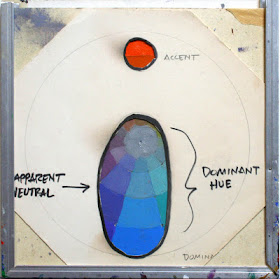of the colors in the composition.
Color accents are usually more highly chromatic than the rest of the picture. If you restrict the entire image to something close to a monochromatic scheme, anything different will jump out and grab the viewer.
In the photo above, the orange color of the shop at night creates a magnet for the attention. Color accents don’t have to be used only for the main focus of interest. They can also be added as a seasoning throughout a picture, to provide relief from large areas of unrelieved hues.
If you have a picture with a strong blue cast, it can help to sneak in a little yellow or orange here and there—just a set of floating dots or an outline, or a weird reflection in a window. This becomes a matter of taste and of momentary inspiration, keeping your color scheme from being too mechanical or predictable.
----
Learn more in my Gumroad tutorial TRIADS: Painting with Three Colors.
Or in my book Color and Light: A Guide for the Realist Painter



Reminds me of Stapleton Kearns’ advice about “smuggling red” into a green landscape — carefully placing a bit of red here and there to enliven the scene.
ReplyDeleteWhat I especially like about the photo is that the eye "wants" to be drawn by the perspective / lights, but is irresistably attracted / distracted by the orange spot.
ReplyDeleteJames, funny how your color gamut chart looks exactly like "Impression soleil levant" by Claude Monet.
ReplyDelete